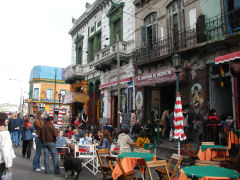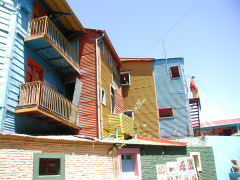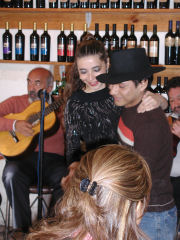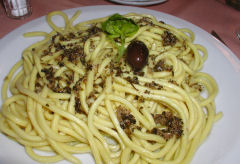 Buenos Aires – Satuday was one of those gorgeous, you must be outside, sort of days. As part of my plan to keep exploring new neighborhoods we hopped on the bus to La Boca, “the mouth,” which is the original river port in Buenos Aires, and, in essence, the start of a trip up the Rio Plata. A momentary digression here. Rio Plata means the Silver River, and it is generally translated that way, if someone bothers to translate it. The story is, that when the Spanish arrived here, they thought that sailing up the river would take them to the fabled silver mines of northwest South America. Turns out, of course, that the Rio Plata is a distributary river off of the Amazon. No silver mines. The weird thing, some folks translate Rio Plata as “river plate,” which would actually be Rio Plato. Despite that not being its name on any map I could find (though googling does find it used here and there), it is not an uncommon thing to hear. I’m guessing it comes from either just plain mistranslation, or from someone who changes the ending of plata to plato because they think that grammatically they have to to keep both endings masculine.
Buenos Aires – Satuday was one of those gorgeous, you must be outside, sort of days. As part of my plan to keep exploring new neighborhoods we hopped on the bus to La Boca, “the mouth,” which is the original river port in Buenos Aires, and, in essence, the start of a trip up the Rio Plata. A momentary digression here. Rio Plata means the Silver River, and it is generally translated that way, if someone bothers to translate it. The story is, that when the Spanish arrived here, they thought that sailing up the river would take them to the fabled silver mines of northwest South America. Turns out, of course, that the Rio Plata is a distributary river off of the Amazon. No silver mines. The weird thing, some folks translate Rio Plata as “river plate,” which would actually be Rio Plato. Despite that not being its name on any map I could find (though googling does find it used here and there), it is not an uncommon thing to hear. I’m guessing it comes from either just plain mistranslation, or from someone who changes the ending of plata to plato because they think that grammatically they have to to keep both endings masculine.
 The story that they’ll tell you is that La Boca was originally home to all the shipyard workers. It grew up in a somewhat fascinating way. In order to afford to build their houses, the workers took (I’ve heard both that they did this illegally and that the ship companies allowed them to, who knows?) “extra” ship timbers, planks, and sheet metal, and turned them into houses. To make them more attractive, they also spirited off the excess paint used for the ships, most of which was in fairly vivid primary colors. La Boca has, at least in its central area, kept that look, and has now become one of the most common scenes on a Buenos Aires postcard. (Some say that this is just a story and the whole thing was made up to create a tourist attraction.) The area is also the heart of the area where tango and milonga flourished, with its seedy waterfront bars and restaurants. The opportunity was seized many years ago, and La Boca is a big draw for the tourist world, especially on weekends, when artisan fairs, outside cafes, and more souveniers than you can shake a stick at multiply. It’s also home, a few blocks outside of the touristy center, to the stadium for the Boca Juniors, arguably one of Argentina’s, and certainly Buenos Aires’ most popular soccer teams. [The “true” story apparently is that the entire pretty colors thing is was a street art project in the 1970s put together by Quinquela Martín, one of the area’s most important and well known artists.]
The story that they’ll tell you is that La Boca was originally home to all the shipyard workers. It grew up in a somewhat fascinating way. In order to afford to build their houses, the workers took (I’ve heard both that they did this illegally and that the ship companies allowed them to, who knows?) “extra” ship timbers, planks, and sheet metal, and turned them into houses. To make them more attractive, they also spirited off the excess paint used for the ships, most of which was in fairly vivid primary colors. La Boca has, at least in its central area, kept that look, and has now become one of the most common scenes on a Buenos Aires postcard. (Some say that this is just a story and the whole thing was made up to create a tourist attraction.) The area is also the heart of the area where tango and milonga flourished, with its seedy waterfront bars and restaurants. The opportunity was seized many years ago, and La Boca is a big draw for the tourist world, especially on weekends, when artisan fairs, outside cafes, and more souveniers than you can shake a stick at multiply. It’s also home, a few blocks outside of the touristy center, to the stadium for the Boca Juniors, arguably one of Argentina’s, and certainly Buenos Aires’ most popular soccer teams. [The “true” story apparently is that the entire pretty colors thing is was a street art project in the 1970s put together by Quinquela Martín, one of the area’s most important and well known artists.]
 It’s one of the few neighborhoods in Buenos Aires, at least within the city’s “core” that you still see street food. Yes, in other places you’ll see the occasional hot dog stand (panchos they call them), and vendors of roasted peanuts are ubiquitous, but there’s little else. In La Boca it’s still possible to get all sorts of sandwiches with meats straight off the “grill,” generally made from a sliced in half oil drum, at many points along the winding pathways. You will also be harangued constantly to buy this or that, check out the “only” authentic souveniers in the district, etc. With the cafe tables scattered in the streets it’s impossible to avoid them, and each spot has at least one person out on foot trying to direct tourists to tables. We decided we may as well participate in the fun and grabbed a table at La Rueda, Magallanes 854, where, we were assured, we’d have the best food in Buenos Aires.
It’s one of the few neighborhoods in Buenos Aires, at least within the city’s “core” that you still see street food. Yes, in other places you’ll see the occasional hot dog stand (panchos they call them), and vendors of roasted peanuts are ubiquitous, but there’s little else. In La Boca it’s still possible to get all sorts of sandwiches with meats straight off the “grill,” generally made from a sliced in half oil drum, at many points along the winding pathways. You will also be harangued constantly to buy this or that, check out the “only” authentic souveniers in the district, etc. With the cafe tables scattered in the streets it’s impossible to avoid them, and each spot has at least one person out on foot trying to direct tourists to tables. We decided we may as well participate in the fun and grabbed a table at La Rueda, Magallanes 854, where, we were assured, we’d have the best food in Buenos Aires.
 Food aside, and that’s where it should have been placed, we had a fun time. A couple of tango dancers and two guitar players were entertaining, and the dancers took turns grabbing folks from the crowd and teaching them a few dance steps, ending in photogenic poses, of course. Henry, who as a folklore dance teacher could dance rings around either of them, jumped at the chance, and got the guitarists to play some classic Peruvian music, which was not only a fun little change of pace for both the entertainers and the diners, but started a wave of tourists from other Latin American countries asking to dance to their own countries’ music. It culminated in a group of eight Chilean teens demonstrating one of their favorite dances, and the staff didn’t seem to mind that they got a break from their own show. Back only momentarily to the food – mediocre empanadas, a salad that was barely edible, and this plate of “fettucini with pesto.” Beyond the obvious wrong noodle, I’m sorry, but pesto doesn’t consist of a drenching of olive oil, some chopped garlic, and a few flakes of dried basil (okay, there’s one leaf of fresh basil on top for decoration). Salt helped, but not much. My guess is, this is pretty typical of most La Boca restaurants in the heart of tourism town, it’s probably best to just drop in for a cup of coffee and the show.
Food aside, and that’s where it should have been placed, we had a fun time. A couple of tango dancers and two guitar players were entertaining, and the dancers took turns grabbing folks from the crowd and teaching them a few dance steps, ending in photogenic poses, of course. Henry, who as a folklore dance teacher could dance rings around either of them, jumped at the chance, and got the guitarists to play some classic Peruvian music, which was not only a fun little change of pace for both the entertainers and the diners, but started a wave of tourists from other Latin American countries asking to dance to their own countries’ music. It culminated in a group of eight Chilean teens demonstrating one of their favorite dances, and the staff didn’t seem to mind that they got a break from their own show. Back only momentarily to the food – mediocre empanadas, a salad that was barely edible, and this plate of “fettucini with pesto.” Beyond the obvious wrong noodle, I’m sorry, but pesto doesn’t consist of a drenching of olive oil, some chopped garlic, and a few flakes of dried basil (okay, there’s one leaf of fresh basil on top for decoration). Salt helped, but not much. My guess is, this is pretty typical of most La Boca restaurants in the heart of tourism town, it’s probably best to just drop in for a cup of coffee and the show.
[…] Buenos Aires – Nothing of major note in the food and wine world has happened (or been made to happen by me) in the last day or two, unless you count that now that I’ve got my kitchen equipment, I whipped up some pesto last night to go with pasta. Pesto here tends to be a strange imitation, like someone once heard about it but doesn’t quite know what it is – usually just pasta tossed with a little olive oil, garlic, and dried basil. I didn’t go for a traditional basil and pinenute one, I used what I had on hand, but got the right consistency for a cilantro and almond pesto served over ricotta and ham stuffed ravioli. […]
[…] Pastas seem to be the specialty at this venue, with an interesting and creative sounding selection of 8-10 on the menu, including daily specials. There are other plates available as well, but as this seemed to be the focus, I headed in the general direction of noodles. The raviolini sounded perfect – a filling of goat cheese, ricotta, and cured ham, with an arugula, walnut, and sun-dried tomato pesto. The ravioli were plump and about the size of what we might consider a normal one, small by local standards where they tend to be the size of sofa cushions, but just right in my view. The filling was rich and well seasoned. The pesto was, well, once again, not pesto. One day it might be interesting to see who brought the idea of pesto here and have them burned in effigy. In this case, the sun-dried tomatoes had been blended with olive oil until they were basically a fine powder, and the whole thing became sort of an oily paste. The ravioli were dressed in that and then topped with toasted walnuts and whole arugula leaves. The flavors were right, it was tasty, if a bit oily, it’s just the concept that’s off. […]
[…] After lunch, and declining our waiter’s offer to call us a cab, we headed out into a slight drizzle to check out the rest of La Boca. Enroute to the touristy area, we found this building at the corner not far from El Obrero. Hard to see in this photo, but the building has some amazing arched windows and beautiful architecture. A little bit of online research this morning determines that this is the former main electric plant for the city, built in 1916, and bought by the municipal government less than a year ago for five million pesos. A planned thirty million peso renovation is to turn this into the city’s main classical music auditorium. An odd location, no doubt, but part of the renewal of the area and one that will no doubt bring both pluses and minuses to the neighborhood. […]
[…] leads to a fun riot of color, that while perhaps not as striking (and not as easy to get to) as the Caminito in La Boca, which shows up on postcards and is a regular stop on local tours – mostly so that the guides can […]
[…] for souvenir shops and shilling for amazing restaurants (that aren’t). In general, other than an obligatory visit before I knew what it was all about, I avoid the Caminito like the plague that it is (it also […]